
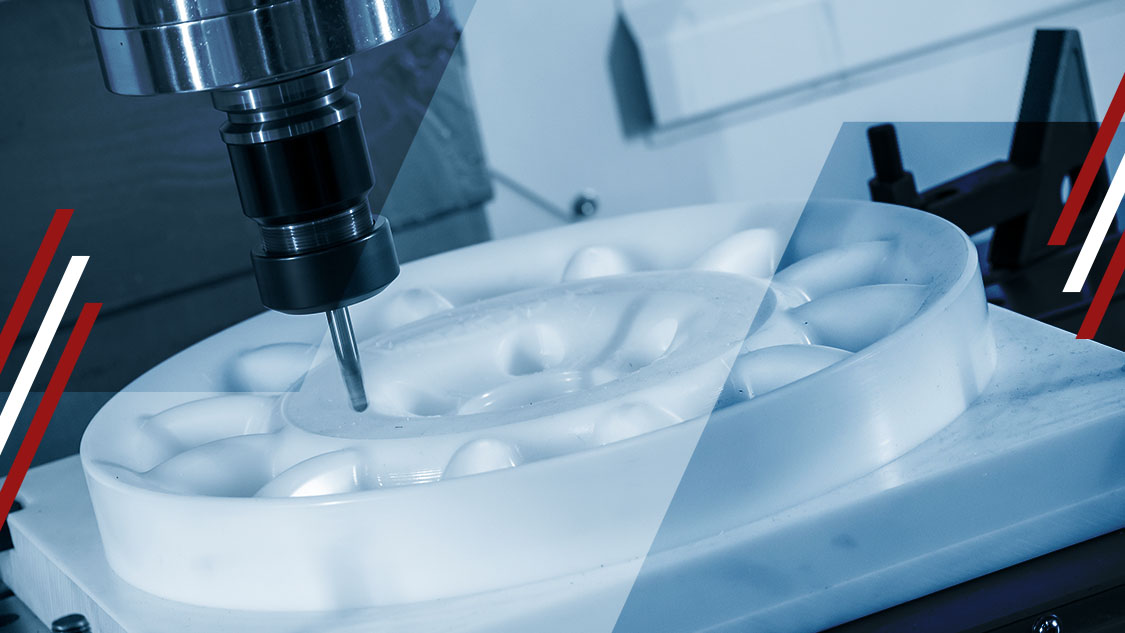
Jump to:
Many manufacturers turn to CNC routing and milling machines for custom-built parts. But what is the difference between a CNC router and a CNC mill? They both perform similar functions but have very different characteristics. You use them with different materials, and you have to be mindful of their production capabilities as you work with them.
Both machines are computer-controlled, hence the acronym CNC, which stands for computer numerical control. These computerized machines gained popularity in the middle of the 20th century.
CNC machinery run off of computer design programs, called computer-aided design (CAD) or computer-aided manufacturing (CAM). Both routers and mills work by moving a cutting tool around the workpiece across several axes. The tool makes cuts into the workpiece, revealing the desired shape. These cuts can include sculpting or contouring in addition to complete cuts.
You can use CNC cutting machines to create a variety of products, from cozy kitchen chairs to tiny electronic parts. Both routers and mills use a tool called an end mill or a router bit, which has a wide range of capabilities. Many projects will require more than one end mill or router bit to achieve the right combination of cuts.
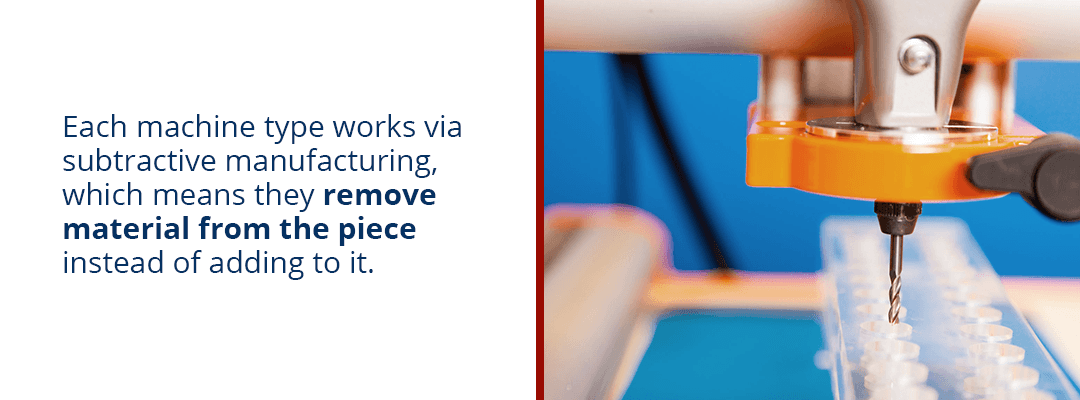
Each machine type works via subtractive manufacturing, which is the process of removing material from the piece instead of adding to it. An example of the opposite process, additive manufacturing, would be 3D printing, which takes an existing piece of material or starts from scratch and adds material to create the desired shape.
CNC routers and CNC milling machines perform similar standard tasks in significantly different ways. The first step is understanding the difference between these two machines to choose the best one for your applications.
Learn More About Our CNC Machining Services
CNC routers distinguish themselves by the materials they can handle. CNC routers aren’t designed to cut hard materials like steel and titanium. Instead, you’d generally use routers to cut softer materials like plastic, foam and wood. Some routers can also work with soft metals like aluminum.
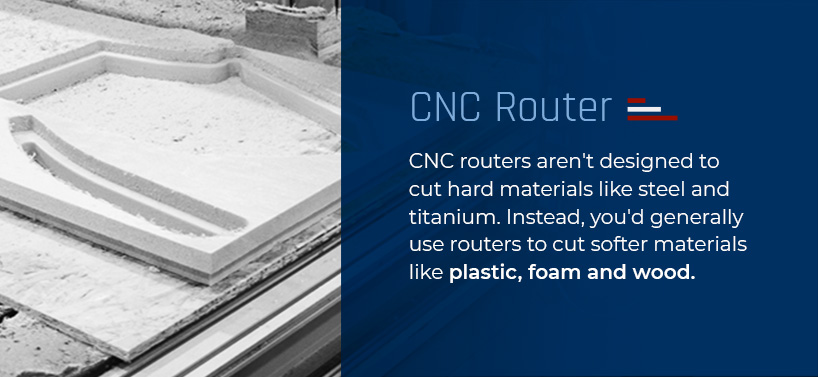
One reason CNC routers can only handle softer substances is because of the way they deliver power to the cutting tool. Routers cut much faster than mills, but they have less torque since they use rotational speed to drive the force to the tool. Routers quicken the machining process and are ideal if you need to make multiples of a product.
While a router’s revolutions per minute (RPM) is much faster than a mill’s, mills are the better choice for industrial-grade materials since routers don’t have the same amount of power. At the same time, routers offer fast reproduction when you need consistent manufacturing abilities, keeping cutting time to a minimum.
However, CNC routers aren’t as accurate as milling machines, so mills are best for projects requiring high precision levels. Routers’ stationary workpiece design is partially responsible for their lower precision capabilities.
CNC routers usually keep their materials on their table, using the spindle head to move across the X, Y and Z axes. Most routers have at least three axes, but some have four to six, making them useful for more complicated projects. In contrast, CNC mills move the material itself, as well as the end mill, achieving more accurate angles.
The cutting surface of a CNC router machine is often wide enough to accommodate the large sizes of many softer materials. For example, if you’re cutting into wood, you might use a board that’s several square feet.
While routers have large cutting areas, their Z-axis clearance is often more shallow, which can cause difficulties when trying to fit some workpieces in the machine. However, routers come in many sizes and types. You can use small machines for DIY projects and larger machines for industrial applications.
Router bits work like drill bits. Different tool shapes and sizes will influence how your cut looks when finished. You can have straight bits, rabbeting bits, chamfer bits, beading bits and molding bits, among many others.
Each bit has a different shank and maximum speed to help increase stability and smoothness and decrease chatter. Router bits dull over time, so you’ll have to keep an eye on them. Higher-quality bits may last longer due to better materials.
Since routers have large work surfaces, their design is less rigid than mills. Even so, this spatial flexibility gives routers their high machine speeds.
Routers are also ideal for cutting pieces from large sheet materials. Depending on the size of the router and materials you use, you can often even cut the edges of a sheet without repositioning the material or reprogramming the machine.
You can use a router to create large-format items like signs, wood carvings and cabinet fronts.
The CNC milling machine comes into play for heavy-duty jobs. Materials like steel, aluminum and even titanium will be right at home on a CNC mill.
Ultimate tensile strength is a measure of how well a material withstands being pulled apart, recording the maximum stress it can take before it breaks. Below are the tensile strengths of many common machining materials, measured in pascals (MPa):
The strength of traditional materials like wood is very different from more heavy-duty metals such as stainless steel. The stronger metals need machines designed to handle their unique properties. These substances make milling a common approach for a wide variety of machine parts, especially those requiring high precision and accuracy.
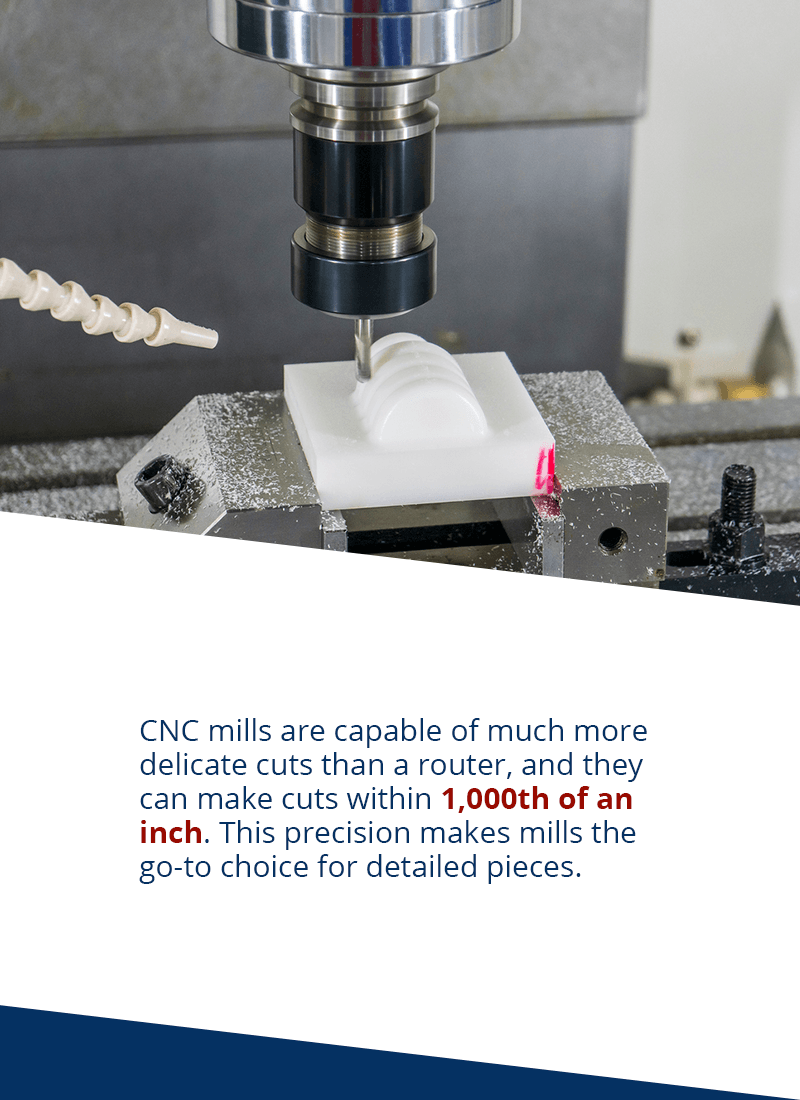
CNC mills can create more delicate cuts than routers, achieving precision within one 1,000th of an inch. This precision makes mills ideal for creating detailed pieces. CNC mills, though designed to work with strong metals, can also work with some soft materials. If the work is intricate or delicate, a mill may still be the way to go for a softer material.
One reason CNC milling machines are so precise is the configuration of the axes. While CNC routers move their router bits along materials that stay on the table, mills move their workpieces along linear axes:
Learn About Our CNC Machining Services
This axis design provides more clearance along the Z-axis, allowing for thicker cuts and more intricate designs. A benefit to this configuration is that the mill itself can flip the workpiece, eliminating the need for operators to reposition the piece to reach other sides. One drawback is the smaller cutting area, but this is often not an issue when working with higher-value metals that come with less excess material.
A milling machine is much more precise than a router but takes more time to complete a job. To make up for the slower speed, the mill uses more torque. With this power, it can handle much tougher jobs to remove materials from the hardest of metals.
To ensure they can cut hard metals, mills are much more substantial and expensive than routers. They’re typically made of die-cast iron or another incredibly hard material. This construction provides stability and enough structure to handle the high torque.
A milling machine uses an end mill to cut. This piece is similar to a drill bit in that it comes in many different shapes and configurations that offer various cuts.
Some end mills are better for creating specific shapes than others. Scalloping, for instance, takes on very different qualities when performed with a flat or a ball end mill.
The shape of the end mill flute, which is the direction the spiral goes, will also influence your machining. The flute affects aspects like your chip load, feed rate and surface finish. Using the correct end mill for your project is crucial for a satisfactory result. Working with metal is very different from working with wood or other soft materials, so you’ll need to partner with someone who knows the subtleties of this milling practice.
Since CNC mills have a small cutting area, their cutting tool range of motion has a small scope as well. While this compact design limits the size of the materials you can use, it also makes the machine more rigid, giving it the strength it needs to cut hard materials.
This rigidity and tighter range of motion also allow CNC mills to cut more accurately. CNC mill precision is ideal for creating parts that require tight tolerances.
Mills are most useful when creating small parts that fit into larger machines or other assemblies. You may even combine router and mill production capabilities to create large, lightweight components and more intricate parts for the same product all in one shop.
These versatile machines can get a lot done if you use the right one for the job. Some of the key differences between CNC mills and CNC routers are:
One of the most significant differences lies in the materials you can use with these machines. Depending on the goal of your project, you may need to consider just how you’ll be machining it.
You can cut soft materials, like wood, foam and plastic, on either, but these materials typically cut better on routers. You should cut any hard metal, such as titanium and steel, on a milling machine, as it’s the only CNC machine that can cut such sturdy materials.
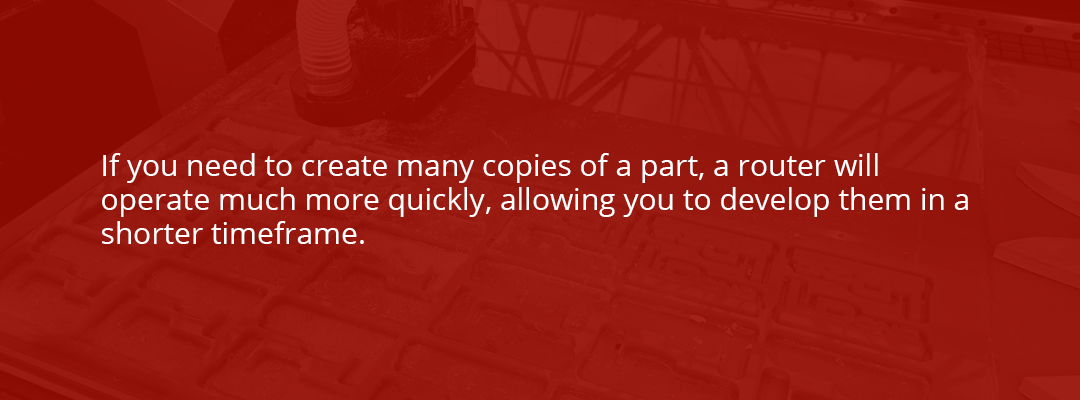
You’ll need to factor machine speed into your decision. If you need to create many copies of a part, a router will operate much more quickly, allowing you to develop them in a shorter timeframe. A CNC mill, on the other hand, will offer unmatched precision, but its cutting process will take much longer.
If you’re making a large order, such as parts for an airplane, you’ll need a precise machine to produce high-quality parts. The precision required for the crucial functioning of large-scale machinery needs the detail offered by a CNC mill, preferably one with five or more axes.
However, if you’re looking to make less critical components, especially out of softer material, a CNC router may be strong and detailed enough to get the job done.
Precision is an essential component of machining parts. If you need parts for highly sensitive applications, such as equipment parts, a CNC mill provides much more accurate cuts than CNC routers. Military, medical and aerospace industries especially need to consider part precision. When lives are on the line, micrometer differences can be vital.
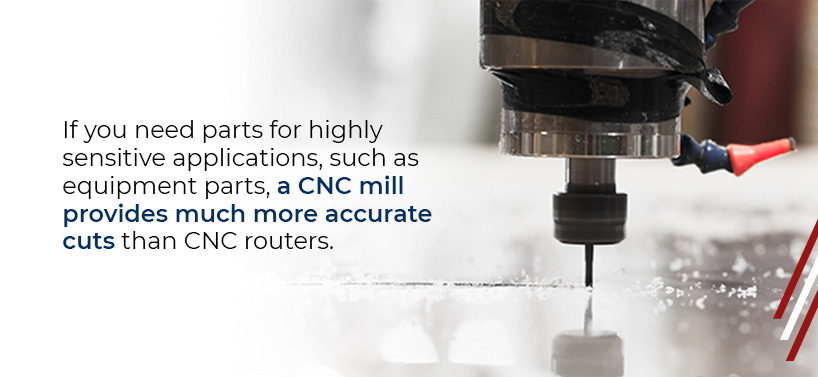
CNC routers are less accurate than mills and work best for basic cuts on soft materials. Meanwhile, CNC mills provide cuts that are more accurate and more intricate than router capabilities. The mill tooltip configuration allows for more complex cutting and shapes.
Since the machines have different space options, you’ll have to consider your project’s starting point. If it needs heavy detail, a CNC mill can offer a deeper Z-axis for deeper cuts in the work. If your source material is very large or wide, such as large blocks of wood or planks of foam, you may have to opt for a router, which has a large cutting area.
With both machines, you get the benefit of a computer-controlled device. CAD software eliminates human error from the physical cutting process. You can recreate the same piece over and over again. Or, if you only need to create one part, you can be confident the machine will make it to the exact specifications you program.
Measurements are accurate, and cuts are sharp and defined. CNC machining turns a software rendering into a completed piece in whatever material you’ve designated. CAD software requires skilled workers to execute the designs efficiently and effectively.
For either machine, the process is typically loud and dirty. Unless you have an enclosed router or mill and an installed vacuuming system, the dust from the device will end up all over the shop and potentially cause health and safety problems. Though the machines are relatively simple to use, the operator needs to use standard best practices and wear the appropriate personal protective equipment to prevent hearing or respiratory issues.
A skilled human operator should also know the signs of a project that’s having problems. If the piece starts burning or shaking or if the tip jumps, there may be an issue with the design or the equipment.
Both machines can create consistent results that you often can’t achieve by hand. Whether you need to make parts for a wooden chair or a gear for an aircraft, CNC machines can get it done.
For cutting-edge custom machining, American Micro Industries creates custom-built parts for a wide variety of industries. We’ve made tiny parts for electronics, precise pieces for aerospace applications and much more. Other fields we’ve worked with include the military, automotive and medical industries.
Many companies in these fields and others trust AMI for more than just parts. They turn to us for unbeatable customer service. We’ll work with you to develop the parts you need. From material selection to the manufacturing process, we can help you find the right approach for even the most unique applications.
We’ve been working with custom components since 1995, and quality is one of our top priorities. We inspect each part thoroughly before we ship it out, and we strive to provide the best customer service we can. If you need a part machined via a CNC router or mill, reach out to an AMI representative. We can discuss the process with you and get started creating the custom parts you require for your application.